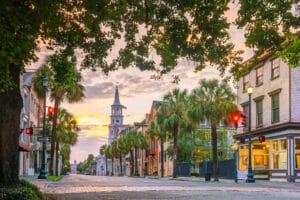
The sacred roads of South Carolina lead to heritage and history
IQ
- 6 Min Read
In order to offer transparency into how our stories are produced and to teach our readers about the importance of media literacy online, the editorial team provides a quick self-rating of the integrity of the articles and the facts presented against the following IQ metrics.
- Published on March 4, 2024
- In Culture
Embark on a journey through South Carolina – from Lowcountry to the Upstate – and unveil a tapestry of rich Black history throughout the state.
From the cobblestone walkways of Charleston to the emerging metropolitan area of Columbia and everything in between, South Carolina has it all. And as you travel through the Palmetto State, the evolution of the state’s rich and complex history is evident. Use this as a guide to your next road trip through South Carolina, discovering the story of the people who once lived here and the culture that remains.
Charleston
Charleston is the oldest and arguably the most popular city in South Carolina. Founded in 1670, the “Holy City” can be considered the origin of SC’s story.
Not far from the city’s center is Gadsden’s Wharf, the first sight that over 30,000 to 40,000 Africans saw as they entered America during the Transatlantic Slave Trade. Gadsden was one of the country’s busiest ports for ships until around 1808.
Present day, the Wharf is home to the International African American Museum. Referred to as IAAM (pronounced I AM), the museum is 150,000 square feet of indoor and outdoor space dedicated to personalizing and vocalizing the stories of people brought to this country against their will.
IAAM features nine galleries with more than 150 historical artifacts, including depictions of the Middle Passage. The museum displays the connection between the enslaved individuals of Africa and the Caribbean and the present-day residents of Charleston and surrounding areas.
From the “slave badges” that ordain the outside corridors of the museum to the groundbreaking work of the Center for Family History, IAAM tells the sordid tale this country’s conception.

Not too far from the museum and located in the heart of the city is Charleston’s City Market. The historical marketplace was once known as the “Slave’s Market” because enslaved individuals and free Black people were able to sell items there. Today, the marketplace maintains its legacy with merchants selling baskets and other goods made from the area’s native sweetgrass. One of the most notable artists is Corey Alston, whose family has been creating precious works of art for over five generations. Alston and his works have been featured everywhere, from the Charleston Visitors Center and the Smithsonian Renwick Gallery to the International African Art Museum.

Beaufort and St. Helena Island
A little less than an hour from Charleston is the small, picturesque city of Beaufort, South Carolina. Beaufort was established in 1711 as a port and hub for cultivating indigo and rice.
Beaufort’s role in the Civil War was due to its location, allowing it to act as a water port for Union forces to invade the Southern coast. Due to its Union occupation, Beaufort was home to some of the first “contraband camps” established during the Civil War. These camps provided a safer alternative for enslaved people seeking freedom. With these, the city became a center for African American self-emancipation and community. The remnants of these beginnings can be seen today on St. Helena Island.
Located five miles east of Beaufort across the Woods Memorial Bridge, the isolated island has been able to preserve the tradition and culture of the Gullah Geechie people, who are direct descendants of the enslaved Africans brought to the area during the slave trade.
In 1862, the first school for formerly enslaved people in America, the Penn School (Penn Center), was established on St. Helena. The Penn School once provided educational and trade services for up to 600 Black students who lived on the island. Dr. Martin Luther King Jr. chose the Penn Center as his place to stay during his visits to the area while contributing to the planning of non-violent protests and marches during the Civil Rights Movement.
The island’s deeply rooted Gullah culture is also preserved and celebrated through other institutions like the Gullah-Geechee Sea Island Coalition, run by Reverend Kenneth Hodges and the Gullah Grub Restaurant, where acclaimed chef William “Bill” Green is at the helm.

Orangeburg
As you travel an hour and 30 minutes north on Highway 95, the large bodies of water and high grass swamps turn into fields and rural farmland. With less than 15,000 people, Orangeburg, SC, isn’t the most prominent city but chronicles significant moments in Black history. The best place to learn about Orangeburg’s involvement in the Civil Rights Movement is at the Cecil Williams South Carolina Civil Rights Museum.
Before Williams was a world-renowned photographer for TIME, Jet Magazine, and other notable publications, he was a student at South Carolina State College (now South Carolina State University). He documented the multiple protests and marches on campus and around the city, including the student protests against segregation at local lunch counters in the 1960s.
The turning point for Orangeburg in the movement was with the gruesome Orangeburg Massacre that occurred on February 8, 1968.
At the hands of state troopers, three Black students were killed and over 30 wounded, stemming from a confrontation at a local bowling alley. The dark chapter in Orangeburg’s history grew national attention and marred the already tense relationship between Black and white people in the area.

As Orangeburg has grown, Black entrepreneurship has as well. Thee Matriarch Bed & Breakfast, owned by husband and wife duo Rachelle and Fred Holmes, is an epicenter for hospitality and events in the city.
Situated in the heart of downtown Orangeburg, the 100-year-old Victorian bed and breakfast boasts eight rooms, each named and decorated in homage to women who have impacted the owners’ lives.
While Rochelle leads the hospitality side of the business, Fred owns the dining experience. Chef Fred’s menu changes daily, but his delicious food is deeply connected to his upbringing in Charleston and his Gullah ancestry. No matter the menu offerings, Rochelle’s award-winning Island Tea is the perfect pairing.

Columbia
South Carolina’s capital, Columbia, is proud of its rich history of Black advancement in education and entrepreneurship.
One of the shining examples of this history is chef Chris Williams, owner of Roy’s Grill. Located in Irmo, SC, a small suburb of Columbia, Chef Williams tells the history of Columbia – and all of South Carolina – through food.

His modern take on classic soul food and barbecue dishes has earned him national recognition, including the title of South Carolina Chef Ambassador. Williams has represented South Carolina in countless food competitions and programs worldwide, giving people an authentic taste of the South.
South Carolina is far more than its significant sites representing the slave trade that built America. It is far more than its areas protecting a culture of people sustained through centuries. It is far more than one man preserving the accurate tail of acts that many may rather forget. It is far more than one chef taking the recipes from his grandfather’s smoker across the world. South Carolina is, in fact, all of those things. It is a culture, it is a people, it is a history that is ready to be experienced by all.
Martie Bowser is a journalist and public relations professional in Charlotte, NC. She enjoys amplifying the voices of POC and women that fill a void within their community. Her favorite things to cover include “person of interest” pieces, small business highlights, pop culture commentary, entertainment features, and everything about Beyoncé. Her bylines can be found in Blavity, Essence, Black Excellence, Signature Bride, Black Wall Street Times, and HipHop Weekly. Martie can be reached via email at martiebowser@detourxp.com.
If you enjoy our perspective on travel and Black culture, please sign up for our newsletter. You should consider joining our travel club, too. Or maybe write a piece for us about your favorite destination. In other words, let’s stay connected!





